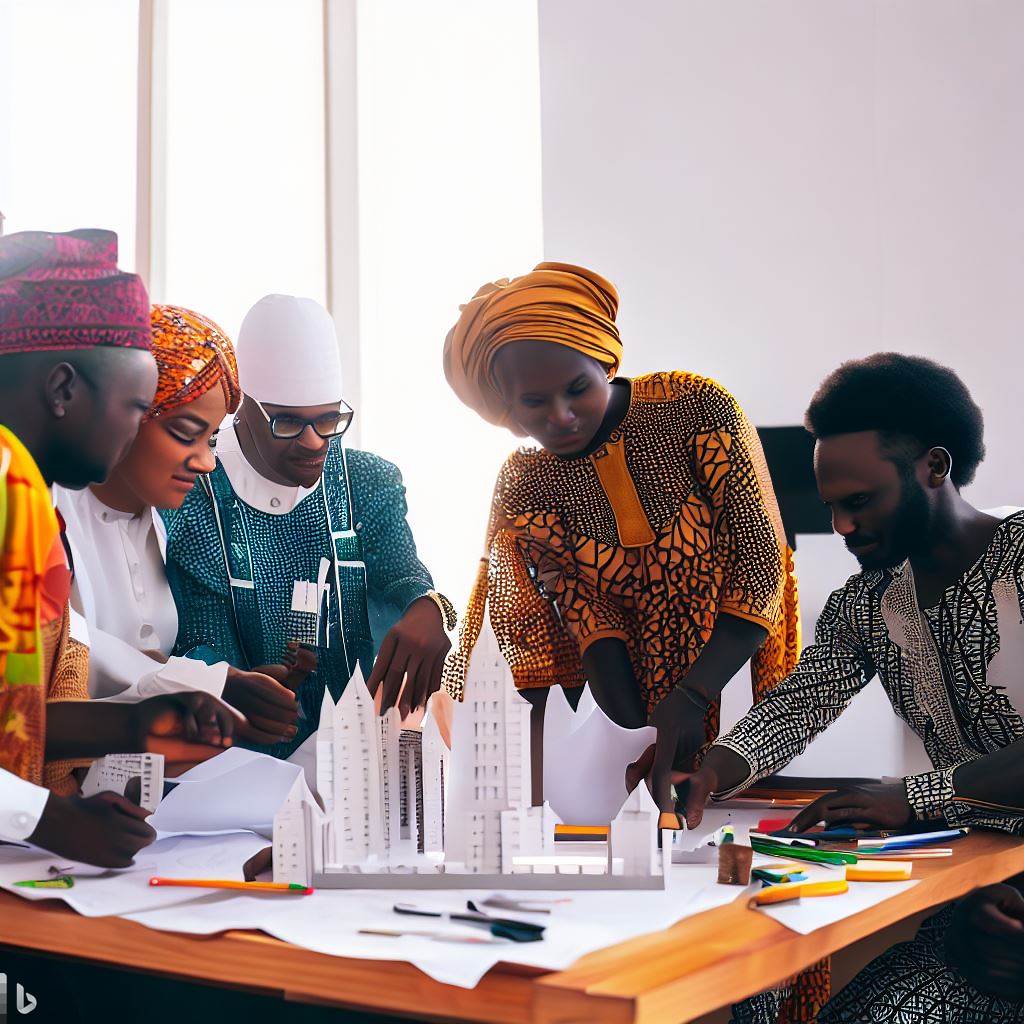Introduction
The housing crisis in Nigeria has become a major challenge, with an estimated housing shortage of about 22 million units.
Lack of access to affordable housing has led to the proliferation of slums and informal settlements, which pose a threat to health, security, and well-being.
Brief overview of housing crisis in Nigeria
The housing crisis in Nigeria can be attributed to a combination of factors, including rapid urbanization, population growth, poor urban planning, inadequate housing policies, and lack of access to financing.
The high cost of building materials, land, and skilled labor also contributes to affordability issues.
Importance of addressing the crisis through architecture
Architecture has a crucial role to play in addressing the housing crisis in Nigeria.
It can provide innovative solutions that respond to the needs of the population while simultaneously addressing issues of affordability, sustainability, and durability.
By incorporating local materials, designing for climatic conditions, and considering cultural practices, architects can create designs that are responsive to the needs of the community.
This approach ensures that housing solutions are sustainable in the long-term and empower communities to take ownership of their development.
In essence, addressing the housing crisis in Nigeria through architecture requires a multifaceted approach that addresses the complex issues at play.
However, the potential for positive impact is immense, with well-designed housing solutions having the ability to transform lives, communities, and even entire cities.
Read: Dissecting The Architect Registration Council of Nigeria
Nigerian Housing Market
The Nigerian housing market is characterized by an increasing population and a growing middle class. However, the housing stock in Nigeria is inadequate, with a housing deficit of more than 22 million units.
The average Nigerian cannot afford a decent house due to the high cost of land and construction materials.
The demographics of the Nigerian housing market present a challenge to affordable housing. The population growth rate in Nigeria is estimated at 2.6% per annum, while the household size averages 5.6 persons.
The majority of Nigerians are low-income earners, with over 60% living below the poverty line. This makes it difficult for them to own a home, let alone afford decent rental accommodation.
The current housing stock in Nigeria is inadequate and does not meet the standards required for safe and healthy living conditions.
Most of the buildings are structurally deficient, making them vulnerable to collapse during a disaster. Furthermore, they lack basic amenities such as electricity, water, and sanitation facilities.
Consequently, the majority of Nigerians live in slums and informal settlements, which lack basic infrastructure.
The challenges facing the Nigerian housing market are manifold
They include inadequate funding, weak legislation, corruption, and ineffective housing policies.
Additionally, the lack of skilled personnel and materials for construction leads to poor-quality buildings, which are prone to collapse.
The government has attempted to address these challenges through various policies, but the impact has been minimal.
Architecture can play a pivotal role in addressing the housing crisis in Nigeria. By designing affordable and sustainable homes, architects can offer a solution to the housing shortage.
Sustainable design ensures that buildings are energy-efficient, environmentally friendly, and cost-effective to maintain.
What’s more, architects can design buildings that are aesthetically pleasing, providing a more desirable living environment.
Architects can also utilize appropriate technology to construct homes
Such as the use of prefabricated building materials. This approach can significantly reduce construction costs and time while improving quality.
Furthermore, architects can apply innovative designs that maximize space utilization, making it possible to build affordable yet spacious homes.
The government can provide incentives and support for architects to encourage the use of sustainable and appropriate technology in housing design.
The government can also provide access to funding for low-income earners to access affordable housing. Also, the government can provide land and infrastructure for the construction of affordable housing, encouraging private investors to participate in the construction of affordable homes.
In summary, the housing crisis in Nigeria requires urgent attention and action. The inadequate housing stock, coupled with the growing population and a struggling economy, presents a significant challenge.
However, by utilizing architecture, appropriate technology, and sustainable design, it is possible to address this crisis.
The government must also provide support and incentives for architects and private investors to participate in the construction of affordable housing.
Read: How Nigerian Architects are Reshaping Urban Landscapes
Role of Architecture in Solving Housing Crisis
Addressing Housing Crisis through Architecture in Nigeria
Architecture plays a vital role in addressing the housing crisis, which is one of the most significant challenges globally.
Nigeria, being Africa’s most populous country, faces a severe housing deficit estimated at 17 million units, which is rising at an alarming rate.
This deficit is due to several challenges, including inadequate funding, poor land management, and the lack of affordable housing finance. However, architecture plays a crucial role in solving these problems.
The importance of architecture in addressing societal problems cannot be overstated. Architecture is more than just the creation of aesthetic buildings; it is an essential tool for social transformation.
The design of buildings can influence the behavior and health of individuals, encourage community cohesion, and improve the overall quality of life.
This is why architects must focus on developing solutions that are both functional and responsive to the needs of the community.
Several successful housing projects in other countries serve as case studies for Nigeria to follow
For instance, Singapore’s public housing scheme has been a success story and has become a global reference point for affordable housing.
Architects in Singapore leverage innovative design and technology to create cost-effective and sustainable housing solutions for their citizens. Similar models can be adopted in Nigeria to address the housing deficit.
In addition, innovative architecture can have a significant impact on the Nigerian housing market. Innovative design and technology can create efficient and affordable housing solutions that go beyond traditional building styles.
For instance, the use of sustainable and locally sourced building materials can significantly reduce the cost of building construction. What’s more, the incorporation of renewable energy sources can reduce energy costs and promote environmental sustainability.
Furthermore, innovative architectural designs can create solutions that are adaptable and cater to the growing and diverse needs of Nigerians.
For instance, the integration of green spaces, community gardens, and communal areas can foster social interaction and promote community development.
Additionally, addressing the housing crisis in Nigeria requires the contribution of multiple stakeholders, including policymakers, investors, and architects.
Architects have a significant role to play in creating innovative and sustainable housing solutions that cater to the diverse needs of Nigeria’s population.
By leveraging innovative technology and designs, architects can create cost-effective and environmentally sustainable solutions that promote community development and improve the quality of life for Nigerians.

Sustainable Housing
In Nigeria, the housing crisis continues to be a significant challenge, with millions of people lacking access to adequate housing. One solution that has gained popularity in recent years is sustainable housing.
Characteristics of Sustainable Housing
- Energy efficiency
- Use of environmentally friendly materials
- Water conservation
- Waste reduction and management
- Integration with nature
Sustainable housing is designed to minimize negative impacts on the environment and to promote a healthy living environment for residents.
Benefits of Sustainable Housing in Nigeria
- Reduces carbon footprint and other environmental impacts
- Improves energy efficiency and reduces energy costs
- Provides a healthier living environment for residents
- Reduces water usage and promotes water conservation
- Minimizes waste and promotes waste reduction and management
Given Nigeria’s rapidly growing population and the strain it places on natural resources, sustainable housing can be an effective way to address the country’s housing crisis while promoting a more sustainable way of living.
Examples of Sustainable Housing in Nigeria and Other African Countries
One notable example of sustainable housing in Nigeria is the Makoko Floating School, which is designed to adapt to changes in water levels and provide a safe, sustainable learning environment for local children.
In Kenya, the iHub building is a sustainable co-working space that uses eco-friendly building materials and promotes energy efficiency through its design and technology.
Another example of sustainable housing in Africa is the Earthship Biotecture community in Zimbabwe, which uses recycled materials and natural resources to create self-sustaining, eco-friendly homes.
Sustainable housing is not only beneficial for the environment, but also for the health and well-being of its residents.
By promoting sustainability in housing design and construction, we can provide safe and healthy living environments for all while reducing negative impacts on the environment.
Read: Leveraging Tech in Nigeria’s Architecture Profession
Low-Cost Housing
Addressing the housing crisis through architecture in Nigeria has become a burning issue in recent years.
The need for low-cost housing has become increasingly apparent in a country where a large percentage of the population lives below the poverty line.
Importance of Low-Cost Housing in Nigeria
Low-cost housing is important in Nigeria because it provides a means for people who can’t afford expensive housing to own a home. It also enables people to live in stable and secure accommodation that is affordable.
Low-cost housing can also be a catalyst for economic growth, as the provision of affordable housing creates jobs and stimulates economic activity.
One Challenge Regarding Low-Cost Housing
One of the challenges facing low-cost housing in Nigeria is the lack of funding. It’s difficult to secure loans from financial institutions to build affordable housing projects due to the high risks involved.
Another challenge is the lack of adequate infrastructure to support low-cost housing. For example, there is often no access to clean water or electricity, which makes it difficult to live comfortably in these homes.
Examples of Successful Low-Cost Housing Projects in Nigeria
Despite these challenges, there have been successful low-cost housing projects in Nigeria. One such project is the Sabo Gari project in Kano state, which was designed by the Nigerian architect, Dr. Ismaila Bala Garba.
The project consists of 1000 low-cost houses, and the design was based on the traditional Hausa architecture of the region.
The use of local materials such as mud bricks and stone helped to reduce costs, and the design incorporates passive cooling techniques to keep the homes cool without the need for air conditioning.
Another successful project is the Jakande Estate in Lagos, which was built in the 1980s during the administration of Governor Lateef Jakande.
The estate consists of over 30,000 low-cost homes, which were built to provide affordable housing for low-income earners in the state.
The homes are relatively small, but they are well-designed and have access to basic amenities such as water and electricity. The estate also has a central market, schools, and healthcare facilities, which make it a self-sustaining community.
Therefore, addressing the housing crisis through architecture in Nigeria requires a concerted effort from architects, developers, and the government.
While there are challenges to providing affordable housing, the success of projects such as Sabo Gari and Jakande Estate shows that it is possible to create affordable homes that are well-designed and provide access to basic amenities.
The importance of low-cost housing cannot be overstated, as it provides a means for people to own a home and live in stable and secure accommodation that is affordable.
As the population of Nigeria continues to grow, it is imperative that efforts are made to address the housing crisis in the country to ensure that everyone has access to a decent place to live.
Read: Architectural Regulations and Policies in Nigeria Explored
Community-Driven Approaches
Addressing the housing crisis in Nigeria requires a community-driven approach in architecture.
This approach involves the active participation and involvement of local communities and stakeholders in the design and construction of housing projects.
Importance of community-driven approaches to architecture
- It ensures that the housing needs and preferences of the community are taken into consideration in the design process.
- It fosters a sense of ownership and pride in the community, which in turn helps to maintain the sustainability and longevity of the housing project.
- It encourages community development and empowerment as individuals are actively involved in decision-making and problem-solving.
Benefits of community-driven approaches to architecture
- It leads to more appropriate and culturally sensitive designs that reflect the values and traditions of the community.
- Community-driven architecture can help to bridge social and economic divisions by providing affordable housing options in areas with high demand.
- It promotes the use of locally sourced materials and labor, creating job opportunities in the area.
- By including community members in the construction process, skills and knowledge are developed, which can be utilized in the future for other community projects.
Examples of community-driven approaches in Nigeria and other countries
- In Nigeria, the Otodo-Gbame community in Lagos managed to construct over 125 houses made from bamboo as a result of their involvement in the design and construction process.
- The Fogo Island Inn, located in Newfoundland, Canada, is an example of community-driven architecture that embraces local traditions and materials, providing employment opportunities and supporting the local economy.
- The Nka Foundation in Ghana has developed a program called “Building From Waste,” where community members are trained to construct eco-friendly homes entirely from locally sourced waste materials.
- In Brazil, the cooperative Habitat for Humanity engages communities in the construction of affordable homes in areas with high demand, using local materials and labor.
Overall, community-driven approaches to architecture can provide housing solutions that not only meet the needs of the community but also foster community development, sustainability, and empowerment.
These approaches should be encouraged and supported as they can create a positive impact on the lives of individuals and the community as a whole.
Conclusion
It is undeniable that addressing the housing crisis in Nigeria is of utmost importance. The country’s population is growing at an alarming rate, and access to adequate housing is becoming increasingly difficult for citizens.
Architecture has a significant role to play in alleviating this crisis. Architects can design innovative and sustainable housing solutions that meet the needs of the community.
By considering factors such as climate, culture, and local materials, architects can create homes that are not only functional but also aesthetically pleasing.
To solve the housing crisis, architects need to prioritize community-driven solutions. This means engaging with the people who will live in these homes and considering their needs, preferences, and lifestyles.
By doing this, architects can create housing that is tailored to the community’s unique context and culture.
Sustainability is also crucial. The design should not only be environmentally friendly but also economically sustainable.
This means creating homes that are affordable and accessible to a wide range of people. Architects must ensure that they are using materials that are locally sourced and easy to maintain.
Essentially, Nigeria’s housing crisis is a significant challenge that architects can help address.
By prioritizing community-driven and sustainable solutions, architects can create homes that meet the needs of the community and preserve the environment.
It is time to encourage innovative solutions that prioritize the needs of the people.




